Hygienic shower for the toilet: a comparative review of designs and installation nuances
In a typical apartment it is difficult to find space for additional amenities. The small bathroom only fits a toilet.But small dimensions are not a reason to refuse to improve your home.
Can't install a bidet? It will be fully replaced by a hygienic shower for the toilet, which takes up a minimum of space and performs the same functions as the familiar hygienic device. Its structure, design features and existing varieties will be discussed in our article.
We will also look at the intricacies of installing various types of hygienic showers, consider the main advantages and list the best manufacturers present on the plumbing market.
The content of the article:
Hygienic shower design
Visually, a shower for performing personal hygiene procedures is almost no different from a regular shower.
Both the device and the other consist of the following parts:
- mixer;
- flexible hose;
- watering can.
There are still differences and they are due to the purpose of the device. Since the head of a hygienic shower should not produce a scattered stream, but a stream focused in one direction and preferably without splashes, it is significantly smaller than that of a conventional shower.
The faucets of some representatives of this special category of showers are equipped with a thermostat, which is very convenient because...There is no need to select the temperature - it is regulated automatically.
The thermostat is designed to mix water passed through the mixer to such a temperature that a person feels comfortable. A one-time adjustment after installing a hygienic shower in the toilet is enough and the thermostat will constantly maintain the set temperature.
The presence of this element will protect against burns, and if there is no hot water in the system, then the unpleasant sensations from this will be minimized.
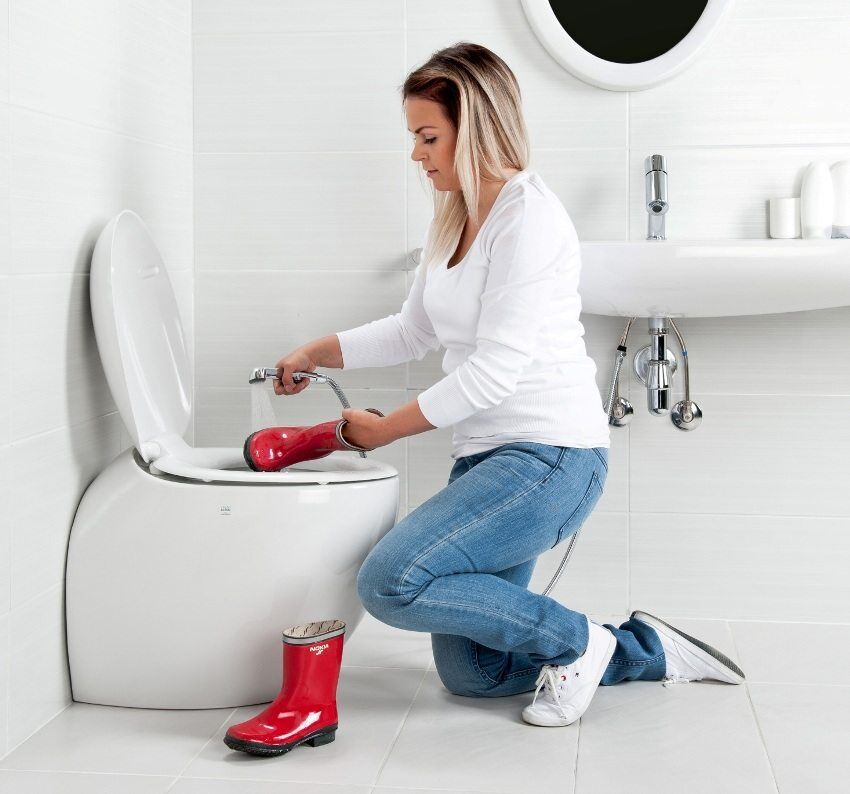
While a regular shower has 2 outlets - for a flexible hose and a spout - a hygienic shower for a toilet simply does not need a second one.
Another feature is that even if the mixer is turned on, water will not flow from it until a special button is pressed, with which the flow is controlled. The jet pressure is adjusted using the mixer lever.
Main types of devices
It is important to know the advantages of such a solution to the problem of keeping your body clean, such as installing a wall-hung or floor-mounted toilet with a hygienic shower.
There are usually 5 main arguments:
- simple installation, carried out in several ways;
- saving space in a small room;
- versatility;
- reasonable price;
- Ease of use.
The concept of a hygienic shower includes plumbing equipment that is completely different in appearance.According to design, there are 4 types of these devices for personal hygiene.
Option #1 - shower toilet
This is equipment of a special design, in which nozzles are built into the body. The control unit is built into the drain tank, which slightly increases its dimensions.
Plumbing fixtures of this type are both floor-mounted and wall-mounted. Manufacturers, in the process of improving their products, are constantly adding new ones to the list of available functions.
We recommend that you familiarize yourself with the models bidet attachments for toilet, present on the market. This information is discussed in detail in our other article.
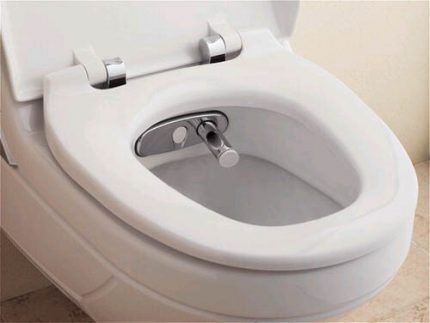
Option #2 - bidet lid
A rather convenient mobile addition to an old toilet can be bidet cover. The control unit built into the lid can turn on the function of heating water to a comfortable temperature, drying, and softly lowering the seat.
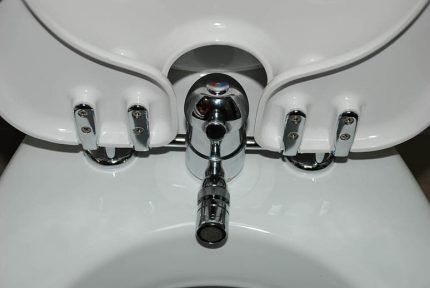
Interesting solution - electronic bidet covers for the toilet. This is luxury sanitary ware produced by well-known brands. Such devices are more functional and comfortable to use, but their price tag is higher than conventional ones.
Option #3 - wall-mounted structure
The option of a hygienic shower mounted on the wall is quite convenient to use. A long flexible hose with a compact watering can is placed near the toilet.They install it to the water supply pipes, which means additional construction work.
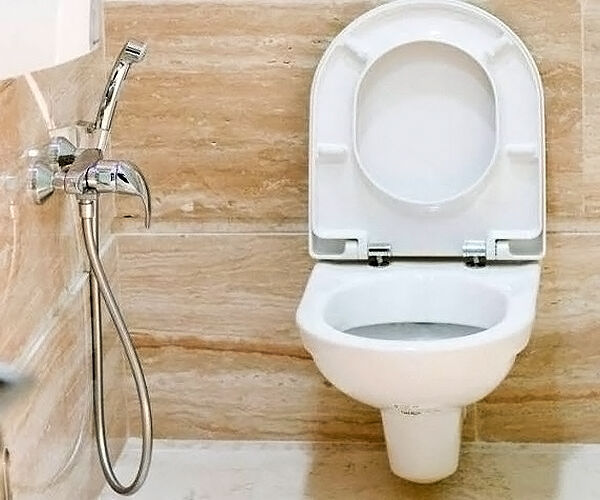
Option #4 - shower connected under the sink
To implement this option, you need to place a sink next to the toilet. The watering can and flexible hose are attached to a specially designed mixer with three outlets. For a separate bathroom, a miniature corner sink is enough.
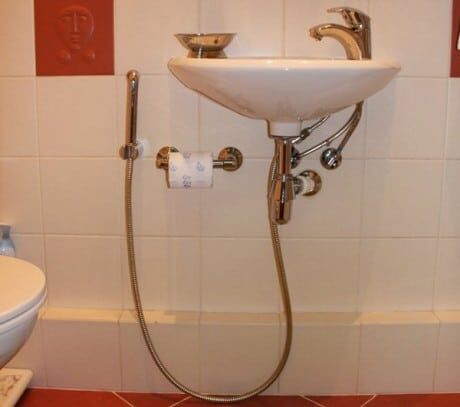
The last option for a hygienic shower is the most profitable, based on the cost of the device itself and its installation. Its advantage is that you don’t have to worry about the water being too hot - its temperature can be adjusted to a comfortable level above the sink.
If you absent-mindedly do not close the tap, the water will flow into the sink, which will prevent your neighbors from flooding.
Types of faucets for hygienic showers
This element of a hygienic shower, according to its design, comes in three types - valve, lever and with a thermostat.
The first is more common and differs in that the water volume is controlled through a valve. It is installed when connecting a hygienic shower to a sanitary cabinet. Thus, it is inconvenient to manually regulate the water temperature; an additional thermostat connection will be required.
A lever mixer is more convenient to use. It works well without additional equipment, so installation is easier. The designers assigned the lever the role of regulating water pressure and temperature. It's easy to manage all this with its help.
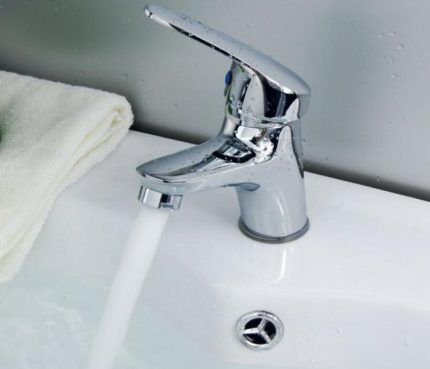
To constantly maintain the optimal temperature and pressure for a specific person or all residents of the apartment, a water jet is more suitable than others mixer-thermostat. Its operation is not affected by any pressure surges in the system. The disadvantage is the high cost of the device.
How to install correctly?
Installation of a shower toilet is carried out using almost the same technology as for a simple toilet. The difference is that you will have to additionally connect the water and install a mixer.
This process for other types of plumbing equipment of this type has significant differences and requires knowledge of many nuances.
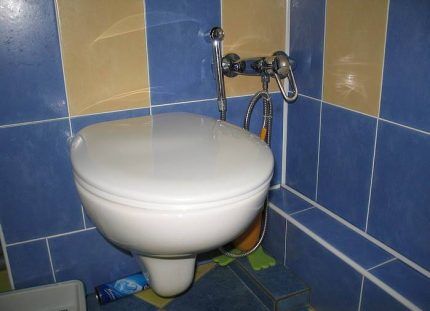
One of them concerns the installation height of the hygienic shower. It is optimal when the level of the holder and mixer coincides with the top line of the tank, and to reach the holder you just need to stretch out your hand.
Installing a hygienic shower on the wall
If the dimensions of the apartment do not allow you to install a sink next to the toilet, you can install an external or built-in model of a hygienic shower on the wall in the toilet.
Having chosen this option, you need to constantly ensure that the mixer does not remain open. Otherwise, pressure remains in both the hose and the watering can, which has a destructive effect on them.
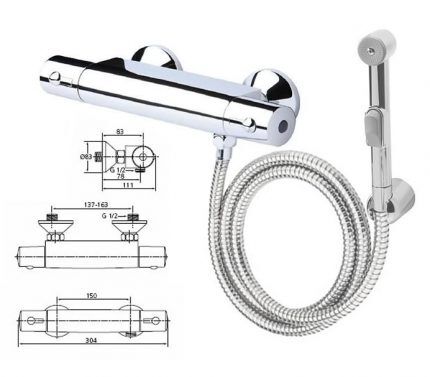
For an external water supply, a tee must be installed to insert the mixer. To do this, turn off the water supply, both cold and hot, and drain the remaining liquid.
Next, proceed to inserting the mixer. To do this, you need to install tees and taps on the pipelines supplying cold and hot water. First of all, turn off the water and release the pressure, then there will be no puddles on the floor.
The next step is to disconnect the flexible outlet of the toilet cistern. Here you need to place a container to drain the remaining water.
Disassemble the connection at the lowest point of hot water supply, placing a container under this place to drain the water. If hot water is not supplied centrally, but individually from a water heater installed in the apartment, then it is often supplied using a plastic pipe connected to an old steel pipe. Therefore, after disconnecting the plastic pipe, unscrew the coupling.
The steel pipe is cleaned and the winding is removed. A layer of sealant in the form of flax tow is wound onto the threads of the tee and pipe, then the tee is screwed on and the metal-plastic pipe is returned to its place. Before this, it is shortened a little and the burrs are removed so that they do not damage the rubber seal.
Next they mount ball valve to shut off the mixer and finally restore the connection.
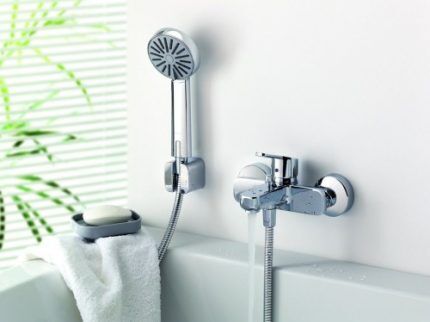
To connect the toilet cistern, install a tee on a pipe with cold water. Just as in the first case, tow is wound around the thread, sealant is applied, and the assembly is installed in place.This gives access to both the mixer and the cistern.
Install a faucet for the toilet tank and connect a flexible hose. To install the first element you will need a corner. The thread on it is very slippery, so notches are applied to it using an adjustable wrench.
A check valve is installed on the pipe supplying cold water to prevent hot water from entering the cold water supply system, which is possible if someone forgets to turn off the faucet. Next we proceed to install the mixer. One of the options for fixing it is to attach it to a special factory-made holder.
You can make a holder yourself by cutting a rectangle out of plywood and attaching it to a wooden block. A hole is made in its center and painted. Insert the mixer into the prepared hole and connect it to the water supply. A hose with a watering can is connected to the mixer through an adapter.
At the end of the process, a wall-hung or floor-mounted toilet with a hygienic shower is tested for the absence of leaks.
The option of installing a built-in hygienic shower is chosen when the walls are not yet lined or during a major renovation of the bathroom, when the old finish is replaced with a new one. A niche is made in the wall, and 3 grooves are laid to it. Two at a time supply water to the mixer, the third serves to remove it and supply it to the shower hose.
A niche is needed to place the mixer, and grooves are needed to hide the pipes. After connecting the pipes, they line the wall, then install the lever and the sleeve with the watering can.
Photo guide for installing the smart kit
Let's look at a clear example of the process of installing a set consisting of a hygienic shower and a bidet lining.
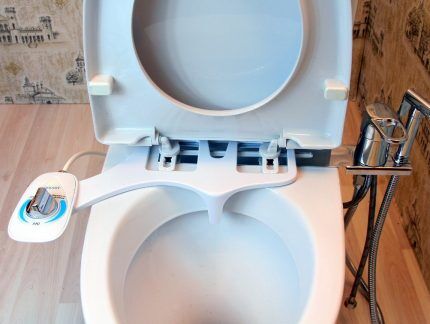
We will install it on a regular toilet.
The bases on which the hygienic devices are located in the non-operating position and the control system for the bidet lid are installed.
Now let's start assembling the mixer and installing it:
Next we will assemble and connect the hygienic shower itself, consisting of bellows hose and shower head, as well as installing a bidet control device:
Finally, we connect the hygienic complex to the water supply branch:
Installation of the bidet cover
Bidet lids are produced without the function of heating water and with it. A set with a device that heats water is powered by electricity. As a rule, this includes a hairdryer.
Electronic shut-off lids often have a button for manual operation and automatic operation. In addition, such a cover may have an audible alarm reminding you to turn off the device. Many models are equipped with a disinfection system. In this case, there is a special container for liquid, which is used to flush both the toilet itself and the nozzles.
As when installing a wall-mounted hygienic shower, before installing the bidet lid, cut off the path of water entering the tank and empty it.The flexible hose supplying water to the tank and the lid on the toilet are removed. Remove the fixing plate from the lid and attach it to the toilet.
Remove the nuts and washers from the mounting bolts, thread them through the holes in the toilet and tighten. The lid is inserted into the grooves until it clicks. Install the tee on the hose, then mount the filter. Insert one nipple into the filter and the second into the lid. Connect the filter and the lid using a tube and check how the water flows.
How to install a shower on a sink?
If you can find a place in the toilet to install a sink, then to install a hygienic shower structure you need to purchase a special mixer, which includes the following elements:
- lever arm;
- spout;
- a spout with a thread to which a hose is connected.
The principle of operation is that when the tap is open, water flows through the spout into the sink, and when the button on the handle is activated, a switch occurs and the toilet begins to work like a bidet.
Manufacturers of the best hygienic showers
This type of plumbing fixtures is widely represented on the market. When choosing, preference should be given to companies with a well-known name. There are not very many manufacturers producing high-quality products.
The following brands are ahead:
- Hansgrohe;
- Damixa;
- Grohe;
- Geberit.
Mixers manufactured at the enterprises of these companies are of excellent quality, easy to use, but their price is appropriate. Savings are still inappropriate in this case. A device purchased for little money will not last long, but a high-quality, but expensive product will justify the investment in it with decades of trouble-free operation.
We recommend that you familiarize yourself with rating of the best models hygienic shower, compiled based on reviews from real users.
To avoid purchasing a fake, you need to check for a quality certificate. An original hygienic shower can be made of brass, stainless steel or other equally high-quality chrome-plated material. The hose must have a metal braid, and the plastic watering can be coated with a special composition.
Conclusions and useful video on the topic
Here is one of the methods for installing a hygienic shower:
We learn how to install a hygienic shower on a sink:
A hygienic shower on the toilet can be installed even in the smallest toilet. It makes the bathroom more functional and convenient, but you shouldn’t use it instead of a traditional shower.
The choice of designs is very large and among them there is sure to be a suitable model. Such equipment is selected based on the layout, size of the toilet, as well as its design features.
Do you use a hygienic shower in your bathroom that you installed yourself? Did you have any difficulties with installation? Are you satisfied with this model and its manufacturer? Share your impressions of use and add photos.
Or maybe you have something to add or recommend to people who are still looking at a hygienic shower? Express your opinion in the comments section.




My wife really wanted to install a bidet in the bathroom. But due to the small size of the bathroom, this is impossible to do. We decided to arrange a hygienic shower for the toilet. We bought all the materials, and in three days the shower was made. We took a mixer with a thermostat. The whole family loved this know-how. Functionality is better than a bidet. Performs all its functions without question.
I saw this mini-shower many times when I was abroad. In the Emirates, for example, every public toilet must have such a device. I want something like this for my home, since the bathroom is separate, and such a shower is simply necessary. But I wanted to connect it to both hot and cold water. An idea arose: buy a regular sink faucet, attach a shower hose to it through some kind of adapter and use it. Tell me, is this a completely crazy idea or does it have a rational grain?
The idea will have a rational grain if the sink is close enough to the toilet.That is, so that you can reach the faucet at arm's length without having to stand up. In this case, this option can really be implemented.
Plus, it is better to choose a multifunctional shower head, in which different modes can be configured and there is a button that, when pressed, opens the flow of water. This is much more convenient than reaching out, opening and closing the pressure on a hygienic shower through a regular mixer.
If the sink is located far from the toilet, then you will have to install a hygienic shower separately so that it is located as close as possible.
The thing is good, but there is one drawback. If you do not close the mixer after use, water will mix in. And the entire riser uses only hot or cold water. Depending on which pressure is greater. For a week now we have not been able to find a man with a club hand because of which the cold is flowing instead of hot.
Please tell me if the bathroom is already tiled, the sink is far away, but the boiler is nearby. So the best option is to mount the shower on the wall (so as not to touch the toilet), supplying it from the boiler?